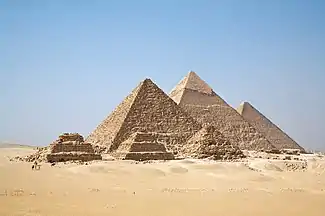Egyptology
Egyptology (from Egypt and Greek -λογία, -logia. Arabic: علم المصريات) is the study of ancient Egyptian history, language, literature, religion, architecture and art from the 5th millennium BC until the end of its native religious practices in the 4th century AD. A practitioner of the discipline is an "Egyptologist". In Europe, particularly on the Continent, Egyptology is primarily regarded as being a philological discipline, while in North America it is often regarded as a branch of archaeology.
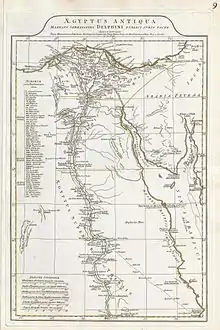
History
First explorers
The first explorers were the ancient Egyptians themselves. Prompted by a dream he had, Thutmose IV restored the Sphinx and had the dream that inspired the restoration carved on the famous Dream Stele. Less than two centuries later, Prince Khaemweset, fourth son of Ramesses II, would gain fame for identifying and restoring historic buildings, tombs and temples, including pyramids.[2]
Graeco-Roman Period
Some of the first historical accounts of Egypt were given by Herodotus, Strabo, Diodorus Siculus and the largely lost work of Manetho, an Egyptian priest, during the reign of Ptolemy I and Ptolemy II in the 3rd century BC. The Ptolemies were very interested in the work of the ancient Egyptians, and many of the Egyptian monuments, including the pyramids, were restored by them. The Ptolemies also built many new temples in the Egyptian style. The Romans also carried out restoration work in Egypt.
Middle Ages
Throughout the Middle Ages travelers on pilgrimages to the Holy Land would occasionally detour to visit sites in Egypt. Destinations would include Cairo and its environs, where the Holy Family was thought to have fled, and the great Pyramids, which were thought to be Joseph's Granaries, built by the Hebrew patriarch to store grain during the years of plenty. A number of their accounts (Itineraria) have survived and offer insights into conditions in their respective time periods.[3]
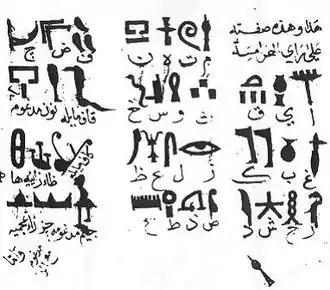
Abdul Latif al-Baghdadi, a teacher at Cairo's Al-Azhar University in the 13th century, wrote detailed descriptions of ancient Egyptian monuments.[4] Similarly, the 15th-century Egyptian historian al-Maqrizi wrote detailed accounts of Egyptian antiquities.[5]
European explorers
European exploration and travel writings of ancient Egypt commenced in the 13th century, with only occasional detours into what could be considered a scientific approach, notably by Claude Sicard, Benoît de Maillet, Frederic Louis Norden and Richard Pococke. In the early 17th century, John Greaves measured the pyramids, having inspected the broken Obelisk of Domitian in Rome, then intended for Lord Arundel's collection in London.[6] He went on to publish the illustrated Pyramidographia in 1646, while the Jesuit scientist-priest Athanasius Kircher was perhaps the first to hint at the phonetic importance of Egyptian hieroglyphs, demonstrating Coptic as a vestige of early Egyptian, for which he is considered a founder of Egyptology.[7]
Modern Egyptology
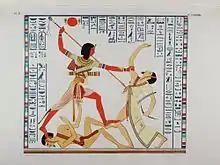
Egyptology's modern history begins with the invasion of Egypt by Napoleon Bonaparte in the late 18th century. The Rosetta Stone was discovered in 1799. The study of many aspects of ancient Egypt became more scientifically oriented with the publication of Mémoires sur l'Égypte in 1800 and the more comprehensive Description de l'Egypte between 1809 and 1829. These recorded Egyptian flora, fauna, and history—making numerous ancient Egyptian source materials available to Europeans for the first time.[8] The British captured Egypt from the French and gained the Rosetta Stone in 1801, the Greek script of which was translated by 1803. In 1822, the respective Egyptian hieroglyphs were transliterated by Jean-François Champollion, marking the beginning of modern Egyptology.[9] With increasing knowledge of Egyptian writing, the study of ancient Egypt was able to proceed with greater academic rigour. Champollion, Thomas Young and Ippolito Rosellini were some of the first Egyptologists of wide acclaim. The German Karl Richard Lepsius was an early participant in the investigations of Egypt—mapping, excavating and recording several sites.
English Egyptologist Flinders Petrie (1853–1942) introduced archaeological techniques of field preservation, recording, and excavation to the field. Many highly educated amateurs also travelled to Egypt, including women such as Harriet Martineau and Florence Nightingale. Both of these left accounts of their travels, which revealed learned familiarity with all of the latest European Egyptology.[10] Howard Carter's 1922 discovery of the tomb of 18th Dynasty King Tutankhamun brought a greater understanding of Egyptian relics and wide acclaim to the field.
In the modern era, the Ministry of State for Antiquities[11] controls excavation permits for Egyptologists to conduct their work. The field can now use geophysical methods and other applications of modern sensing techniques.
In March 2017, the Egyptian-German team of archaeologists unearthed an eight-meter 3,000-year-old statue that included a head and a torso thought to depict Pharaoh Ramses II. According to Khaled El-Enany, the Egyptian Antiquities Minister, the statue was more likely thought to be King Psammetich I. Excavators also revealed an 80 cm-long part of a limestone statue of Pharaoh Seti II while excavating the site.[12][13][14][15][16]
In November 2017, the Egyptian mission in cooperation with the European Institute for Underwater Archaeology announced the discovery of 2.000-year-old three sunken shipwrecks dated back to the Roman Era in Alexandria's Abu Qir Bay.[17][18]
The sunken cargo included a royal head of crystal perhaps belong to the commander of the Roman armies of “Antonio”, three gold coins from the era of Emperor Octavius Augustus, large wooden planks and pottery vessels.[19]
In July 2018, archaeologists led by Zeinab Hashish announced the discovery of a 2.000-year-old 30-ton black granite sarcophagus in Alexandria. It contained three damaged skeletons in red-brown sewage water. According to archaeologist Mostafa Waziri, the skeletons looked like a family burial with a middle-aged woman and two men. Researchers also revealed a small gold artifact and three thin sheets of gold.[20][21][22]
In July 2019, ancient granite columns and a smaller Greek temple, treasure-laden ships, along with bronze coins from the reign of Ptolemy II, pottery dating back to the third and fourth centuries BC were found at the sunken city of Heracleion. The investigations were conducted by Egyptian and European divers led by underwater archaeologist Franck Goddio. They also uncovered the ruins of the city's main temple off of Egypt's north coast.[23][24][25][26]
According to the Al-Ahram, in January 2019, archaeologists headed by Mostafa Waziri revealed a collection of 20 tombs dated back to the Second Intermediate Period in Kom Al-Khelgan. The burials contained the remains of animals, amulets, and scarabs carved from faience, round and oval pots with handholds, flint knives, broken and burned pottery. All burials included skulls and skeletons in the bending position and were not very well-preserved.[27][28]
In May 2020, Egyptian-Spanish archaeological mission head by Esther Ponce uncovered a unique cemetery dating back to the 26th Dynasty (so-called the El-Sawi era) at the site of ancient Oxyrhynchus. Archaeologists found tombstones, bronze coins, small crosses, and clay seals inside eight Roman-era tombs with domed and unmarked roofs.[29][30]
In February 2021, archaeologists from the Egyptian Ministry of Tourism and Antiquities announced the discovery of Ptolemaic period temple, a Roman fort, an early Coptic church and an inscription written in hieratic script at an archaeological site called Shiha Fort in Aswan. According to Mostafa Waziri, crumbling temple was decorated with palm leaf carvings and an incomplete sandstone panel that described a Roman emperor. According to researcher Abdel Badie, generally, the church with about 2.1 meters width contained oven that were used to bake pottery, four rooms, a long hall, stairs, and stone tiles.[31][32]
Academic discipline
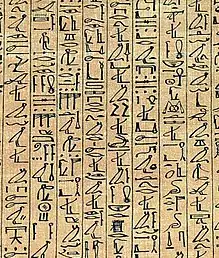
Egyptology was established as an academic discipline through the research of Emmanuel de Rougé in France, Samuel Birch in England, and Heinrich Brugsch in Germany. In 1880, Flinders Petrie, another British Egyptologist, revolutionised the field of archaeology through controlled and scientifically recorded excavations. Petrie's work determined that Egyptian culture dated back as early as 4500 BC. The British Egypt Exploration Fund founded in 1882 and other Egyptologists promoted Petrie's methods. Other scholars worked on producing a hieroglyphic dictionary, developing a Demotic lexicon, and establishing an outline of ancient Egyptian history.[8]
In the United States, the founding of the Oriental Institute at the University of Chicago and the expedition of James Henry Breasted to Egypt and Nubia established Egyptology as a legitimate field of study. In 1924, Breasted also started the Epigraphic Survey to make and publish accurate copies of monuments. In the late 19th and early 20th century, the Metropolitan Museum of Art; the University of Pennsylvania; the Museum of Fine Arts, Boston; the Brooklyn Institute of Fine Arts; and the Institute of Fine Arts, New York University also conducted excavations in Egypt, expanding American collections.[8]
Some universities and colleges offer degrees in Egyptology. In the United States, these include the University of Chicago, Brown University, New York University, Yale University and Indiana University - Bloomington. There are also many programmes in the United Kingdom, including those at the University of Oxford, the University of Cambridge, Swansea University, the University of Liverpool, the University of Manchester, and the University of London. While Egyptology is widely studied in continental Europe,[33] only Leiden University offers English taught degree programs in Egyptology.[34]
Societies for Egyptology include:
- The Society for the Study of Ancient Egypt[35]
- The Society for the Study of Ancient Egyptian Antiquities, Canada[36]
- Sussex Egyptology Society Online[37]
- Egypt Exploration Society[38]
According to UCLA, the standard text that scholars referenced for studies of Egyptology was for three decades or more, the Lexikon der Ägyptologie (LÄ). The first volume published in 1975 (containing largely German-language articles, with a few in English and French).[39]
See also
- Artifact (archaeology)
- Cultural tourism in Egypt
- Egyptomania
- Excavation (archaeology)
- List of Egyptologists
Other related disciplines not mentioned in the article:
References
- Thompson 2015, p. 85: "Ancient and modern Egypt became easier to conceptualize because of the prolific French cartographer Jean-Baptiste Bourguignon d’Anville (1697–1782). The greatest mapmaker of his age, Bourguignon d’Anville also had a special interest in ancient geography, one that he wrote would not permit me to neglect Egypt, this country so celebrated in antiquity." Instead of copying older maps and blindly replicating their errors and speculations as had long been the practice he sought reliable data and was content to leave spaces blank rather than fill them with conjectural features. He had no firsthand experience with Egypt, but he carefully pored over every available source modern ancient and Arab as he explained in his ‘’Memoires sur l’Egypte ancienne et moderne’’ (1766). Bourguignon d’Anville's map of Egypt allowed readers to see the relationship of ancient and modern sites much more clearly than before. It continued in use well into the nineteenth century. Although the cartographers of Napoleon's Egyptian expedition made a more accurate map, it was declared a state secret and Bourguignon d’Anville's map was printed in its place in the great ‘’Description de l’Egypte.’’"
- © Greg Reeder retrieved GMT23:48.3.9.2010
- Chareyron, Nicole (2005). Pilgrims to Jerusalem in the Middle Ages. New York City: Columbia University Press. pp. 127–97. ISBN 0231132301.
- El Daly, Okasha (2005). Egyptology: The Missing Millennium: Ancient Egypt in Medieval Arabic Writings. London, England: UCL Institute of Archaeology Publications. pp. 127–97. ISBN 1-84472-063-2.
- Description of Egypt: Notes and Views in Egypt and Nubia, Made During the Years 1825, 26, 27, and 28 : Chiefly Consisting of a Series of Descriptions and Delineations of the Monuments, Scenery, &c. of Those Countries ... Cairo, Egypt: American University in Cairo Press. 2000. ISBN 978-9774245251.
- Chaney, Edward (2011). "Roma Britannica and the Cultural Memory of Egypt: Lord Arundel and the Obelisk of Domitian". In Marshall, David; Wolfe, Karin; Russell, Susan (eds.). Roma Britannica: Art Patronage and Cultural Exchange in Eighteenth-Century Rome. British School at Rome. pp. 147–70. ISBN 978-0904152555.
- Woods, Thomas (2005). How the Catholic Church Built Western Civilization. Washington DC: Regenery. ISBN 0-89526-038-7.
- "Egyptology" (PDF). Saylor.org. Retrieved 6 March 2012.
- Foerster, Brien (2014). "Lost Ancient Technology of Egypt" (PDF). hiddenincatours.com.
- Chaney, Edward (2006). "Egypt in England and America: The Cultural Memorials of Religion, Royalty and Revolution". In Ascari, Maurizio; Corrado, Adriana (eds.). Sites of Exchange: European Crossroads and Faultlines. Amsterdam, Netherlands: Rodopi, Amsterdam and New York. pp. 39–74.
- The Ministry of State for Antiquities Archived 2011-09-27 at the Wayback Machine retrieved 18:55GMT 3.10.11
- "Massive Statue of Ancient Egyptian Pharaoh Found in City Slum". National Geographic News. 2017-03-10. Retrieved 2021-01-14.
- Thomas Page. "Colossal 3,000-year-old statue unearthed from Cairo pit". CNN. Retrieved 2021-01-14.
- Youssef, Nour (2017-03-17). "So Many Pharaohs: A Possible Case of Mistaken Identity in Cairo (Published 2017)". The New York Times. ISSN 0362-4331. Retrieved 2021-01-14.
- Aboulenein, Ahmed (2017-03-09). "Colossus probably depicting Ramses II found in Egypt". Reuters. Retrieved 2021-01-14.
- Katz, Brigit. "Huge Statue of Egyptian Pharaoh Discovered in Cairo". Smithsonian Magazine. Retrieved 2021-01-14.
- "Sunken vessels dating back to Roman era discovered in Alexandria". Egypt Independent. 2017-11-21. Retrieved 2020-12-28.
- "2,000-year-old Roman shipwrecks discovered near coast of Alexandria, Egypt". Haaretz.com. Retrieved 2020-12-28.
- "Archeologists find Roman shipwrecks off Egypt's north coast". phys.org. Retrieved 2020-12-28.
- Specia, Megan (2018-07-19). "Inside That Black Sarcophagus in Egypt? 3 Mummies (and No Curses) (Published 2018)". The New York Times. ISSN 0362-4331. Retrieved 2020-12-29.
- "Clues Point to Occupant of Ancient 'Mystery' Sarcophagus". Science. 2018-07-17. Retrieved 2020-12-29.
- Daley, Jason. "Scientists Begin Unveiling the Secrets of the Mummies in the Alexandria 'Dark Sarcophagus'". Smithsonian Magazine. Retrieved 2020-12-29.
- Topics, Head. "Archaeologists discover a sunken ancient settlement underwater". Head Topics. Retrieved 2019-08-17.
- EDT, Katherine Hignett On 7/23/19 at 11:06 AM (2019-07-23). "Ancient Egypt: Underwater archaeologists uncover destroyed temple in the sunken city of Heracleion". Newsweek. Retrieved 2019-08-17.
- Santos, Edwin (2019-07-28). "Archaeologists discover a sunken ancient settlement underwater". Nosy Media. Retrieved 2019-08-17.
- History, Laura Geggel 2019-07-29T10:37:58Z. "Divers Find Remains of Ancient Temple in Sunken Egyptian City". livescience.com. Retrieved 2019-08-17.
- "3,500-Year-Old Tombs Unearthed in Egypt's Nile Delta - Archaeology Magazine". www.archaeology.org. Retrieved 2020-09-11.
- "Ancient tombs and prehistoric burials found in Nile Delta - Ancient Egypt - Heritage". Ahram Online. Retrieved 2020-09-11.
- Mahmoud, Rasha (2020-05-26). "Egypt makes major archaeological discovery amid coronavirus crisis". Al-Monitor. Retrieved 2020-09-29.
- "Unique cemetery dating back to el-Sawi era discovered in Egypt amid coronavirus crisis". Zee News. 2020-05-28. Retrieved 2020-09-29.
- "Ruins Of Ancient Ptolemaic Temple Discovered In Egypt - Greek City Times". Retrieved 2021-02-05.
- February 2021, Laura Geggel-Editor 02. "Ruins of ancient church and temple discovered in Egypt". livescience.com. Retrieved 2021-02-05.
- "Where to Study Egyptology". Guardian's Egypt. Retrieved 13 November 2011.
- "Egyptology, Introduction ~ Masters in Leiden". en.mastersinleiden.nl. Archived from the original on 2017-01-18. Retrieved 2017-01-18.
- The Society for the Study of Ancient Egypt 20:53GMT.14.3.2008
- The Society for the Study of Ancient Egyptian Antiquities, Canada 20:58GMT 3.8.2008
- Sussex Egyptology Society Online retrieved GMT21:27.26.2.2006
- Egypt Exploration Society Archived 2012-04-06 at the Wayback Machine retrieved 16:36GMT 3.10.11
- Angeles Project Development Information;Homepage retrieved 17:47GMT 3.10.11
Further reading
- David, Rosalie. Religion and magic in ancient Egypt. Penguin Books, 2002. ISBN 0-14-026252-0
- Chaney, Edward. 'Egypt in England and America: The Cultural Memorials of Religion, Royalty and Revolution', in: Sites of Exchange: European Crossroads and Faultlines, eds. M. Ascari and A. Corrado (Rodopi, Amsterdam and New York,2006), 39–74.
- Chaney, Edward. "Roma Britannica and the Cultural Memory of Egypt: Lord Arundel and the Obelisk of Domitian", in Roma Britannica: Art Patronage and Cultural Exchange in Eighteenth-Century Rome, eds. D. Marshall, K. Wolfe and S. Russell, British School at Rome, 2011, pp. 147–70.
- Hill, Marsha (2007). Gifts for the gods: images from Egyptian temples. New York: The Metropolitan Museum of Art. ISBN 9781588392312.
- Jacq, Christian. Magic and mystery in ancient Egypt. Souvenir Press, 1998. ISBN 0-285-63462-3
- Manley, Bill (ed.). The Seventy Great Mysteries of Ancient Egypt. Thames & Hudson. ISBN 0-500-05123-2
- Mertz, Barbara. Red Land, Black Land: Daily Life in Ancient Egypt. Dodd Mead, 1978. ISBN 0-396-07575-4
- Mertz, Barbara. Temples, Tombs and Hieroglyphs: A Popular History of Ancient Egypt. Bedrick, 1990. ISBN 0-87226-223-5
- Mysteries of Egypt. National Geographic Society, 1999. ISBN 0-7922-9752-0
- Reeves, Nicholas (2000). Ancient Egypt: The Great Discoveries. Thames & Hudson. ISBN 978-0-500-05105-4.
- Thompson, Jason (2015). Wonderful Things: A History of Egyptology: 1: From Antiquity to 1881. The American University in Cairo Press. ISBN 978-977-416-599-3.
- Thompson, Jason (2016). Wonderful Things: A History of Egyptology: 2: The Golden Age: 1881–1914. The American University in Cairo Press. ISBN 978-977-416-692-1.
- Thompson, Jason (2018). Wonderful Things: A History of Egyptology: 3: From 1914 to the Twenty-first Century. The American University in Cairo Press. ISBN 978-977-416-760-7.
External links
| Look up Egyptology or Egyptologist in Wiktionary, the free dictionary. |
- "North African Archaeology". ANTIQUITYOFMAN.COM: Anatomical and Behavioural Evolution. Archived from the original on March 8, 2010. Retrieved October 15, 2006. Sections, all with content relevant to antiquity: Articles; Books, journals and external resources; Expeditions and fieldwork opportunities; and Professional organizations)
- "Egyptologists' Electronic Forum (EEF), version 64". Egyptological Societies and Institutes. September 13, 2015. List shows Egyptology societies and Institutes
- Egyptology at Curlie
- "Egyptology Books and Articles in PDF online". The University of Memphis Institute of Egyptian Art and Archaeology. March 6, 2015. Archived from the original on May 30, 2015.
- "Egyptology collection". The Metropolitan Museum of Art.
- "A key to the translation exercises in Sir Alan Gardiner's Egyptian Grammar, Electronic publications, Egyptological databases, Dictionaries and lexicography, Useful Web sites & Main libraries with Egyptological holdings". Griffiths Institute, OXFORD UNIVERSITY.
- Hawass, Zahi; Brock, Lyla Pinch, eds. (2000). "Egyptology at the Dawn of the Twenty-First Century Proceedings of the Eighth International Congress of Egyptologists". American University in Cairo Press. Cairo. Retrieved October 10, 2011.
- "Rare Books and Special Collections Digital Library Underwood & Underwood Egypt Stereoviews Collection". American University in Cairo.
- "Czech Institute of Egyptology, Faculty of Arts, Charles University in Prague". Czech Institute of Egyptology.
- "Global catalogue of Egyptian archeological records belonging to Institutions of all over the world". globalegyptianmuseum.org (without archive-url website). Retrieved Oct 27, 2018.
